64 Cores of Rendering Madness: The AMD Threadripper Pro 3995WX Review
by Dr. Ian Cutress on February 9, 2021 9:00 AM EST- Posted in
- CPUs
- AMD
- Lenovo
- ThinkStation
- Threadripper Pro
- WRX80
- 3995WX
CPU Tests: Encoding
One of the interesting elements on modern processors is encoding performance. This covers two main areas: encryption/decryption for secure data transfer, and video transcoding from one video format to another.
In the encrypt/decrypt scenario, how data is transferred and by what mechanism is pertinent to on-the-fly encryption of sensitive data - a process by which more modern devices are leaning to for software security.
Video transcoding as a tool to adjust the quality, file size and resolution of a video file has boomed in recent years, such as providing the optimum video for devices before consumption, or for game streamers who are wanting to upload the output from their video camera in real-time. As we move into live 3D video, this task will only get more strenuous, and it turns out that the performance of certain algorithms is a function of the input/output of the content.
HandBrake 1.32: Link
Video transcoding (both encode and decode) is a hot topic in performance metrics as more and more content is being created. First consideration is the standard in which the video is encoded, which can be lossless or lossy, trade performance for file-size, trade quality for file-size, or all of the above can increase encoding rates to help accelerate decoding rates. Alongside Google's favorite codecs, VP9 and AV1, there are others that are prominent: H264, the older codec, is practically everywhere and is designed to be optimized for 1080p video, and HEVC (or H.265) that is aimed to provide the same quality as H264 but at a lower file-size (or better quality for the same size). HEVC is important as 4K is streamed over the air, meaning less bits need to be transferred for the same quality content. There are other codecs coming to market designed for specific use cases all the time.
Handbrake is a favored tool for transcoding, with the later versions using copious amounts of newer APIs to take advantage of co-processors, like GPUs. It is available on Windows via an interface or can be accessed through the command-line, with the latter making our testing easier, with a redirection operator for the console output.
We take the compiled version of this 16-minute YouTube video about Russian CPUs at 1080p30 h264 and convert into three different files: (1) 480p30 ‘Discord’, (2) 720p30 ‘YouTube’, and (3) 4K60 HEVC.
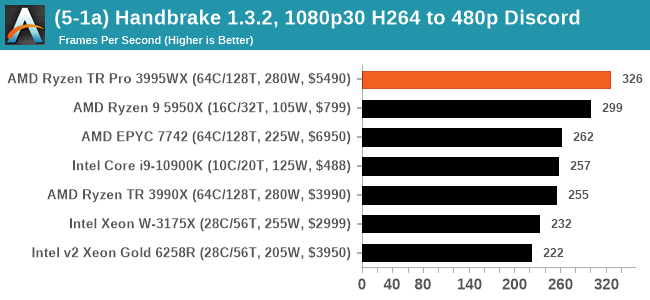
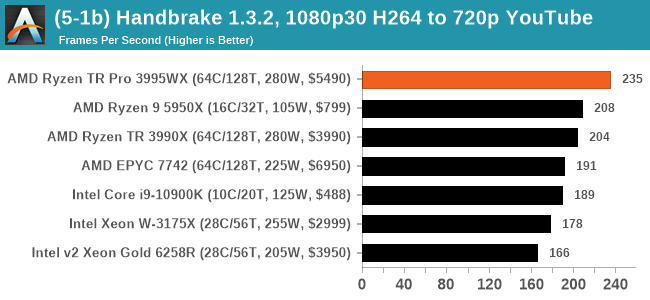

For the lower resolution modes, it would appear that the increased memory bandwidth plays a role for the 3995WX and 7742, although single core frequency also means a lot. Moving to the HEVC metrics, the Ryzen 9 takes a win here, but the 3995WX still goes above the 3990X.
7-Zip 1900: Link
The first compression benchmark tool we use is the open-source 7-zip, which typically offers good scaling across multiple cores. 7-zip is the compression tool most cited by readers as one they would rather see benchmarks on, and the program includes a built-in benchmark tool for both compression and decompression.
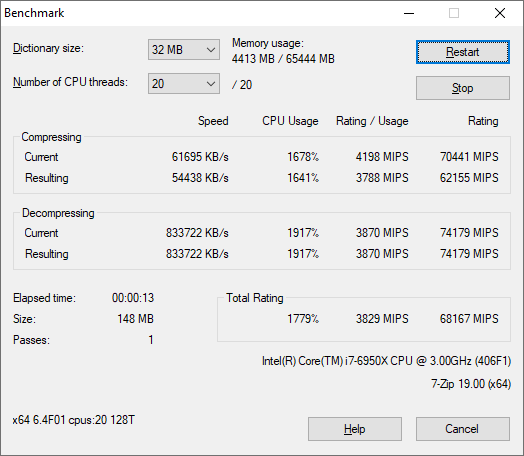
Example Test Run on an Intel 10-core i7-6950X
The tool can either be run from inside the software or through the command line. We take the latter route as it is easier to automate, obtain results, and put through our process. The command line flags available offer an option for repeated runs, and the output provides the average automatically through the console. We direct this output into a text file and regex the required values for compression, decompression, and a combined score.
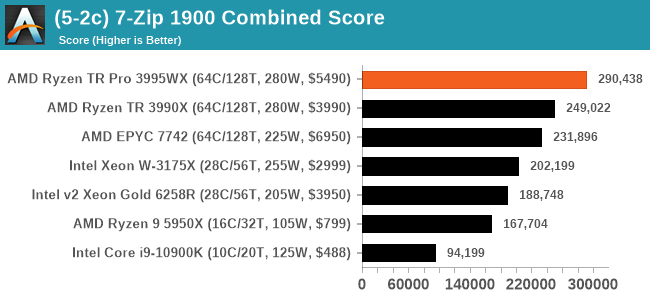
This is a 16.6% win for the TR Pro 3995WX.
AES Encoding
Algorithms using AES coding have spread far and wide as a ubiquitous tool for encryption. Again, this is another CPU limited test, and modern CPUs have special AES pathways to accelerate their performance. We often see scaling in both frequency and cores with this benchmark. We use the latest version of TrueCrypt and run its benchmark mode over 1GB of in-DRAM data. Results shown are the GB/s average of encryption and decryption.
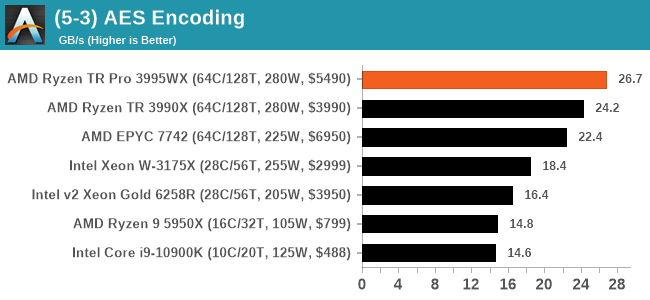
WinRAR 5.90: Link
For the 2020 test suite, we move to the latest version of WinRAR in our compression test. WinRAR in some quarters is more user friendly that 7-Zip, hence its inclusion. Rather than use a benchmark mode as we did with 7-Zip, here we take a set of files representative of a generic stack
- 33 video files , each 30 seconds, in 1.37 GB,
- 2834 smaller website files in 370 folders in 150 MB,
- 100 Beat Saber music tracks and input files, for 451 MB
This is a mixture of compressible and incompressible formats. The results shown are the time taken to encode the file. Due to DRAM caching, we run the test for 20 minutes times and take the average of the last five runs when the benchmark is in a steady state.
For automation, we use AHK’s internal timing tools from initiating the workload until the window closes signifying the end. This means the results are contained within AHK, with an average of the last 5 results being easy enough to calculate.
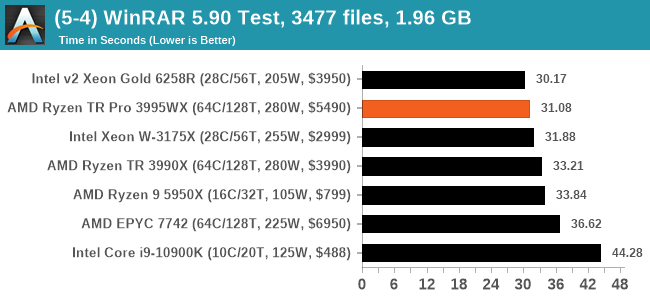
WinRAR is variable threaded, but the Xeon Gold takes the win here - even compared to the Xeon W-3175X. It's all relatively close at the top end.



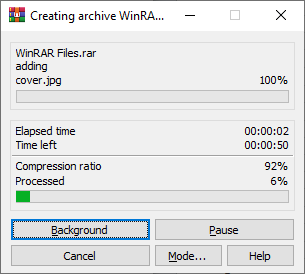








118 Comments
View All Comments
Silma - Tuesday, February 9, 2021 - link
TLDR: unless you absolutely need a 3995WX feature not included in a 3990X, the 3990X is a much better choice: almost same performances, $1,500 less.ingwe - Tuesday, February 9, 2021 - link
Yeah absolutely. Still exciting to me with the increased DDR capacity.kgardas - Tuesday, February 9, 2021 - link
Well, not always! For some cases W-3175x was better and even for some cases poor small 5950x was better. So target application always matter here.For me AVX512 perf of 3175x is breath taking (8x speedup of AVX512 code in comparison with non-AVX!) and pity that AMD is not supporting this yet. Speaking about spec. code, Saphire Rappids AMX will be something to look for.
frbeckenbauer - Tuesday, February 9, 2021 - link
It's unlikely amd will ever implement AVX512 directly. It's too niche and takes up a huge amount of die space, you're better off going to GPU instead.Oxford Guy - Tuesday, February 9, 2021 - link
If AMD were to implement it, Intel has AVX1024 waiting in the wings.Smell This - Tuesday, February 9, 2021 - link
Get me the Nuke Plant ... STAT!
We have an order for Chipzillah AVX1024, and need more Gigawatts.
kgardas - Tuesday, February 9, 2021 - link
Not avx1024, but amx: https://fuse.wikichip.org/news/3600/the-x86-advanc...ishould - Tuesday, February 9, 2021 - link
Is AMX something that might be able to be implemented as a chiplet? If so, AMD might be going this route so the customers that need it can get itElstar - Friday, February 12, 2021 - link
I can't find a link to it, but during the Xeon Phi era (rest in peace), the Intel engineers were proud of the EVEX encoding scheme and that it could support AVX1024 or AVX2048 someday. I think now that Xeon Phi is dead and normal Xeons have embraced AVX512BW and AVX512VL, this dream is dead too.kgardas - Tuesday, February 9, 2021 - link
Look at the benchmark numbers and then think what TR will be able to do with proper avx512 support. Yes, AMD definitely needs to implement it. Also it'll need to implement AMX in the future if they would not like to become second class x86 citizen again.